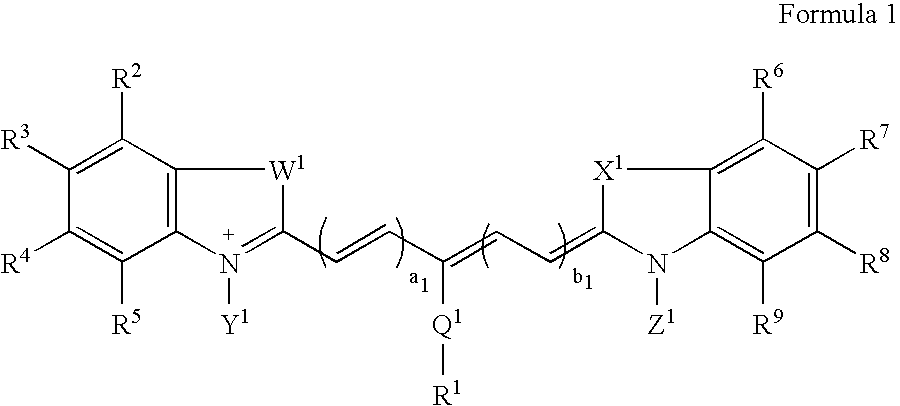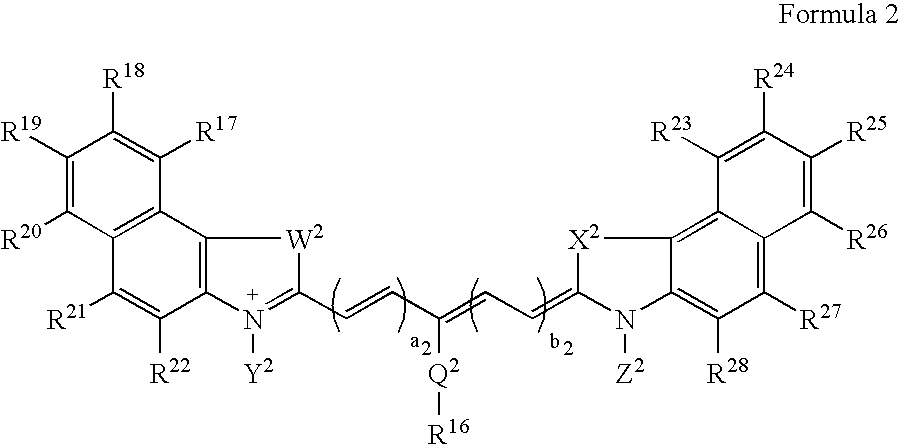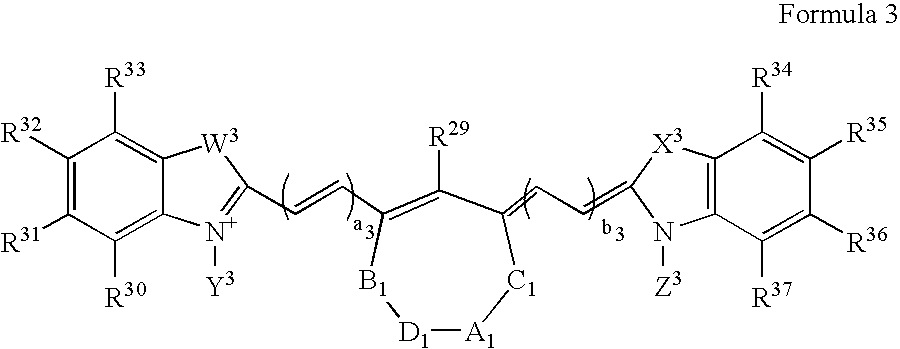Receptor-avid exogenous optical contrast and therapeutic agents
a technology of exogenous optical contrast and receptor, applied in the field of tumor visualization and detection, can solve the problems of hepatobiliary toxicity, inability to induce large changes in the absorption and emission properties of these dyes, and various attempts to obviate this problem have not been very successful, so as to preserve the fluorescence efficiency of dye molecules and enhance tumor detection
- Summary
- Abstract
- Description
- Claims
- Application Information
AI Technical Summary
Benefits of technology
Problems solved by technology
Method used
Image
Examples
example 1
Synthesis of Bis(ethylcarboxymethyl)indocyanine Dye
(FIG. 1, R1, R2=fused phenyl: A=CH2, n=1 and R═R′═CO2H)
[0072] A mixture of 1,1,2-trimethyl-[1H]-benz[e]indole (9.1 g, 43.58 mmoles) and 3-bromopropanoic acid (10.0 g, 65.37 mmoles) in 1,2-dichlorobenzene (40 mL) was heated at 110° C. for 12 hours. The solution was cooled to room temperature and the red residue obtained was filtered and washed with acetonitrile:diethyl ether (1:1) mixture. The solid obtained was dried under vacuum to give 10 g (64%) of light brown powder. A portion of this solid (6.0 g; 16.56 mmoles), glutaconaldehyde dianil monohydrochloride (2.36 g, 8.28 mmoles) and sodium acetate trihydrate (2.93 g, 21.53 mmoles) in ethanol (150 mL) were refluxed for 90 minutes. After evaporating the solvent, 40 mL of a 2 N aqueous HCl was added to the residue. The mixture was centrifuged and the supernatant was decanted. This procedure was repeated until the supernatant became nearly colorless. About 5 mL of water:acetonitrile...
example 2
Synthesis of Bis(pentylcarboxymethyl)indocyanine Dye
(FIG. 1, R1, R2=fused Phenyl; A=CH2, n=4 and R═R′═CO2H)
[0073] A mixture of 1,1,2-trimethyl-[1H]-benz[e]indole (20 g, 95.6 mmoles) and 6-bromohexanoic acid (28.1 g, 144.1 mmoles) in 1,2-dichlorobenzene (250 mL) was heated at 110° C. for 12 hours. The green solution was cooled to room temperature and the brown solid precipitate formed was collected by filtration. After washing the solid with 1,2-dichlorobenzene and diethyl ether, the brown powder obtained (24 g, 64%) was dried under vacuum at room temperature. A portion of this solid (4.0 g; 9.8 mmoles), glutaconaldehyde dianil monohydrochloride (1.4 g, 5 mmoles) and sodium acetate trihydrate (1.8 g, 12.9 mmoles) in ethanol (80 mL) were refluxed for 1 hour. After evaporating the solvent, 20 mL of a 2 N aqueous HCl was added to the residue. The mixture was centrifuged and the supernatant was decanted. This procedure was repeated until the supernatant became nearly colorless. About ...
example 3
Synthesis of Bisethylcarboxymethylindocyanine Dye
(FIG. 1, R1═R2═H; A=CH2, n=1 and R═R′═CO2H)
[0074] This compound was prepared as described in Example 1 except that 1,1,2-trimethylindole was used as the starting material.
PUM
| Property | Measurement | Unit |
|---|---|---|
| of wavelength | aaaaa | aaaaa |
| temperature | aaaaa | aaaaa |
| temperature | aaaaa | aaaaa |
Abstract
Description
Claims
Application Information
 Login to View More
Login to View More - R&D
- Intellectual Property
- Life Sciences
- Materials
- Tech Scout
- Unparalleled Data Quality
- Higher Quality Content
- 60% Fewer Hallucinations
Browse by: Latest US Patents, China's latest patents, Technical Efficacy Thesaurus, Application Domain, Technology Topic, Popular Technical Reports.
© 2025 PatSnap. All rights reserved.Legal|Privacy policy|Modern Slavery Act Transparency Statement|Sitemap|About US| Contact US: help@patsnap.com



